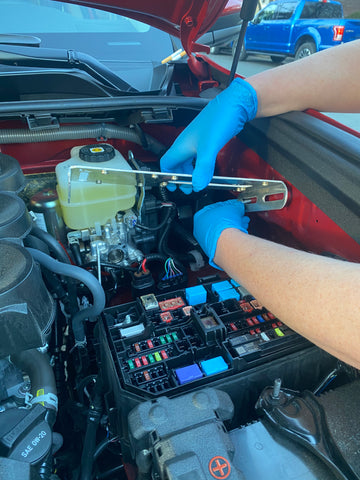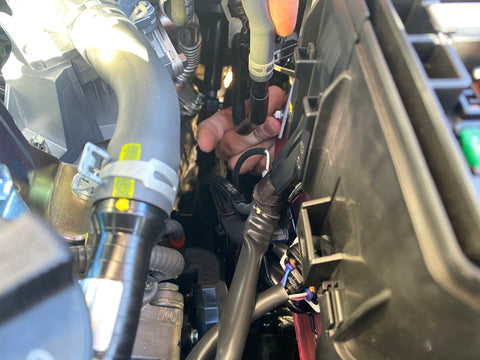Switch-Pros PowerTray w/ Dual MRBF Accessory Bundle - 4Runner/ FJ / GX
The Switch-Pros 9100 changes the game when it comes to adding lights and other aftermarket accessories to a vehicle. But if care is not taken the wires will quickly tangle and become difficult to manage. by providing your aftermarket accessories with a convenient and reliable place to connect, you reduce the chances of something going wrong. and if an electrical gremlin does start causing issues, trouble shooting is much easier when everything is layout out and displayed in an orderly fashion.
Now, you'll want to do as much prep work as possible before installing the Switch-Pros PowerTray system in your vehicle.
Prep work - things to do before the actual install
PowerTray Components:
- Switch-Pros PowerTray
- Support Leg
- Installation Hardware:
- (2) M8 JIS Flange Bolt
- (2) M6 JIS Flange Bolt
- (2) M6 JIS Flange Nut
Accessory Bundle Components:
- Blue Sea 5025 6 circuit fuse block
- Blue Sea 2508 8 circuit terminal block
- Blue Sea 2300 10 screw busbar
- Accessory Hardware:
- (10) #8 x 9/16” Phillips machine screws
- (2) #8 x 3/8” Phillips machine screws
- (1) Rubber grommet
- Perma-Seal Heat shrink ring terminals
- (5) Large
- (5) Small
- Low-profile mini add-a-fuse's w/ 2A fuse
- (2) Ignition and light sense
- Dual MRBF fuse holder
- (1) 125A Marine Rated Battery Fuse
- (1) 100A Marine Rated Battery Fuse
- Battery Cables:
- (1) 26" Length 4GA Power Cable
- (1) 24" Length 4GA Power Cable
- (1) 3" Length 4GA Ground Cable
- (1) 16" Length 4GA Ground Cable
Begin by prewiring the Switch-Pros output leads to the Positive Terminal Block.
- Mount the Switch-Pro and Blue Sea components to the PowerTray using the provided Accessory Hardware.
- The Busbar will use the shorter 3/8" length machine screws; Everything else uses the longer 9/16" length machine screws)

- Route the Switch-Pros wires down under the unit and up though the space between the terminal block and Switch-Pros. Temporarily hold the wires in place by removing the Terminal Block’s screws and reinserting them with the wire under the screw head.

- Once all 12 wires are routed and secured under the screw heads, adjust them for aesthetic/uniformed length. Begin cutting them one by one using the edge of the Positive Terminal Block as a guide. This will ensure they are all uniform in length. (Note: If your wire cutters are too bulky to get in there, use a pen or marker to mark a cutline on the wires so they can be removed and cut)

- Once all the wires are cut, flip the PowerTray over and begin stripping the ends in order to crimp on the heatshrink ring terminals. Lastly, apply heat to the terminals to fully seal and protect the connections from water and corrosion.


- Pro Tip: After the ring terminals are crimped and sealed, remove the Switch-Pros base module from the tray before attaching the wires to the terminal block. This will give the ring terminals more room while screwing them to the Terminal Block. Once the ring terminals are secured to the terminal block, move the SP's base back into location while using the back of the SP to uniformly push all the ring terminals down at the same time. The insulation will be pressing against the back of the base module. So slightly wedge your finger between the the two to add some distance between them so they don't rub.





- Lastly, attach the Negative Stubby Cable taking special care to its orientation as the cable is made with reversed lugs to account for the height differences between the fuse block and busbar.


2) Run the SP harness though the firewall
- Unfortunately I don't have any pics of this process at the moment. But you'll want to do this before you do the actual install so you aren't so cramped.
- One strategy that we use, is to poke a zip tie though the main wiring harness boot on the drivers side firewall. Poke the zip tie through from inside the cab (so the connector can be pulled from the engine compartment, back into the cab). Then tape the connector to the zip tie.
- Pro Tip: Electrical tape works best because it's stretchy and smooth. When taping the connector to the zip tie, start a little higher up on the zip tie and wrap towards the connector. This does two things; First it provides layers to act as the slope so the tape doesn't get hung up when going through the rubber boot; Secondly, starting up higher on the zip tie provides more surface area for the tape to adhere to. Also use some type of lube around the outside of the tape to help it squeeze though the factory wire harness boot on the firewall.
The pre-wiring stage is complete. Next step is to install the PowerTray in your vehicle.
Installation
**NOTE: If you have a 2020+ 4Runner you will first need to relocate a small relay box prior to installation. CLICK HERE to see how.
Step 1: Bolt the PowerTray to the Inner Fender.
Remove your fuse box cover to give you more room for your hand. Start with the back bolt closest to the firewall. Angle the tray up while you begin threading the M8 flange bolt by hand.

Now rotate the tray down so you can install the forward most M8 fender bolt. (Tip: You can keep the tray tilted up for more hand room.)

Finally center the PowerTray between the factory fuse block and master cylinder. Use a small ratchet with 12 mm socket to finish tightening the two fender bolts.
Step 2: Bolt the top of the support leg to the inside lip on the PowerTray.
Note: The support leg has a top and a bottom. The smaller hole at the top attaches to the PowerTray and the elongated hole (on the bottom of the support leg) gets bolted to the lower fender.
It looks cleanest when you attach the support leg to the inside of the bend. Also, put the bolt in from the engine side so the serrated flange nut is on the underside of the tray. Next we'll attach the bottom before fully tightening.

Step 3: Bolt the Support Leg to the Lower Fender.
The elongated hole on the bottom of the support leg will be attached to a preexisting hole on the lower inner fender. This area is best accessed from the wheel well.



Now with the support leg in place, go back up to the top connection. Make sure the support leg is vertical by sliding it forwards/backwards. Then use a 10mm wrench and fully tighten the bolt. The serrations on the flange nut will bite into the aluminum so you don't have to use a wrench on the underside of the tray.
Lastly you want to finish tightening the bottom of the support leg. But before you do, make sure the tray is level by sliding it up and down. (Tip: Put your fuse block cover back on and use its edge as a parallel reference.) Again, the serrated flange nut will bite into the support leg as you tighten, so you can just tighten it from the wheel well.

Cable Routing for Dual MRBF install:
Pretty self-explanatory from the pictures but the Dual MRBF mounts directly to the positive post on the battery and provides circuit protection for both the Blue Sea 5025 fuse block (100A) and Switch-Pros 9100 (125A).
For the Power Cables, connect the load side first and the source (battery) side second. Install the rubber grommet first; Then push the 24" fuse block cable through from underneath. We custom make the fuse block cable with a smaller 6 gauge battery lug to better fit through the rubber grommet. Note: If the grommet wants to pop out when pushing the cable up through, use some lubricant on the lug/heat shrink area and wiggle the cable in a circle motion until it's through the rubber grommet. once though, bend the cable down and secure it to the Blue Seas 6-circuit fuse block.
Next bolt the 26" (slightly longer) SP cable to the positive stud on the Switch-Pros base power module. With both power cables securely attached to the load side, you can attach them to the Dual MRBF terminal fuse holder.
Lastly, run the 14" ground cable from the Blue Seas Busbar to the factory chassis ground bolt found on the inner fender close to the negative post on your battery. Pro Tip: It's easier to first attach the cable to the chassis ground bolt and then the busbar. Note: The factory chassis ground bolt will have an "E" stamped into the head.


